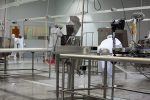Sanitation in a food processing plant is a large-scale effort that many organizations see as an added cost of doing business. Yet, it’s essential and can have costly consequences if done improperly.
Because time is money and facilities want to avoid any necessary downtime, the window for completing proper sanitation procedures is small. Many food processors simply put more people on the job while requiring them to work third shift, hoping to get things done faster.
Automating certain sanitation procedures in your plant can provide real benefits, many of which will help reduce the costs associated with food safety and keeping your facility clean. Here’s a look at the three main ways food plants can save by implementing automated sanitation solutions.
1. Resource Management
When you invest in sanitation automation, one of the biggest advantages is the increased understanding of how resources are being used. This knowledge and improved visibility gives you control of how resources such as water and chemicals are used during sanitation.

Perhaps the most significant area in which facilities experience savings is through reduction of water usage. Automated solutions improve the efficiency of rinse cycles while ensuring appropriate water pressure is being used. Every plant has unique water needs, but you should expect water savings between 30% and 50%, depending on the solutions that are applied.
Sanitation automation will also lead to a reduction in energy costs. Using less water means less energy is required to heat that water. Advancements in sanitation technology have made certain solutions more energy efficient. Features such as multi-stage pumps for full alternation, motors that allow pumps to ramp up and down as needed, and flow switches that send pumps into “hibernate” mode help reduce electricity usage.
Waste water from food processing also needs to be treated before it goes down the drain. Less water treatment means fewer chemicals are needed.
Food processors that introduce automated sanitation solutions will use cleaning chemicals more efficiently. Automation ensures chemicals are dispensed precisely where they are needed at the correct concentration, without any over spray. Again, while every situation is unique, most facilities can expect a 20–30% reduction in chemistry costs.
In the end, you will have a very clear picture of the amount of water and chemistry needed to complete sanitation, and you’ll know the amount of time it should take. That means you can plan for more uptime.
Overall, not only can automation help food processors make efficient use of resources, it also makes them more sustainable.
2. Labor Costs
Labor is yet another resource that can be more effectively managed when there’s an investment in sanitation automation. The labor market is tight, and it is becoming increasingly difficult to hire the people needed to carry out sanitation work.
Sanitation often involves menial and tedious tasks that also require attention to detail. It usually entails working overnight when production stops, and certain responsibilities can be dangerous. At the same time, minimum wage is rising, and many organizations are looking to reduce labor costs.
Introducing sanitation automation can certainly cut labor expenses and remove the need to hire more people, but more importantly, it can make the workers you do have more productive. Automation should be used to eliminate menial tasks from sanitation workers. For example, instead of a person standing in front of a conveyor belt and spraying it down with a hose for hours on end, the job could be easily automated.
We worked with a brewer who was having two employees take as long as three hours to clean a filler. By automating that task, they turned it into a 45-minute job and allowed those employees to refocus their efforts. Plus, the before and after pictures of the equipment show a visible difference in cleanliness.
You can trust an automation solution to do a consistent job, and it will never call in sick.
Still, you’ll always need to have “boots on the ground” and human eyes evaluating sanitation. Automating certain sanitation practices will free up employees to work on more important duties that add value and keep them engaged in their work.
3. Mitigating Safety Risks
The most important thing sanitation automation provides is more peace of mind. No one wants to lose sleep worrying about a failed inspection or the potential for a worker injury. Automation reduces the risk of product contamination and lessens potentially dangerous situations for employees.
For instance, spiral freezers are particularly precarious areas to clean. Automating its cleaning process eliminates the need for a worker to maneuver through an unsafe space, reducing the likelihood of a workplace injury.
Human labor can also lead to human error. But, when sanitation tasks are automated, they become more consistent and easily repeatable. This is especially important for cleaning hard-to-reach problem spots that become harborage areas for bacteria. There may be a tendency among human workers to skip areas they can’t reach, or fail to clean them properly, but a machine cleans everything the same every time.
The monetary risk of contamination inside your facility is significant. For example, if Listeria were to take up residence in a plant, it could cost your business millions of dollars.
According to a study from the Food Marketing Institute and Grocery Manufacturers Association, the average food product recall will have direct costs of $10 million while indirect costs could reach into the hundreds of millions. That’s because you also need to consider the ongoing cost of a damaged brand reputation, not to mention lost productivity from business interruptions and lost profits from disposing of potentially contaminated product.
Sanitation Automation: The Future is Now
There are many reasons to start implementing automation into your food and beverage plant’s sanitation practices. Food processors in Europe have been quicker to adopt these solutions because many of the same issues U.S. manufacturers face, such as wages and resource scarcity, can be even more pronounced overseas.
As the labor market in the United States presents challenges for hiring managers, and drought conditions in some regions make water a scarce commodity, automation presents an opportunity to bring your facility into the future. Add to those concerns the increased regulations from FSMA, and there is even more reason to invest in dependable sanitation solutions.
Food processors need to find trusted advisors who can evaluate operations inside the plant and look for ways to implement automation in ways that make the largest impact.
While there is certainly an upfront cost in automating sanitation, the potential savings and added visibility these solutions provide won’t take long to pay for themselves. In most cases, facilities that invest in sanitation automation will see a return within a year to 18 months. If done properly, you can achieve impressive cost-saving results through automation.







